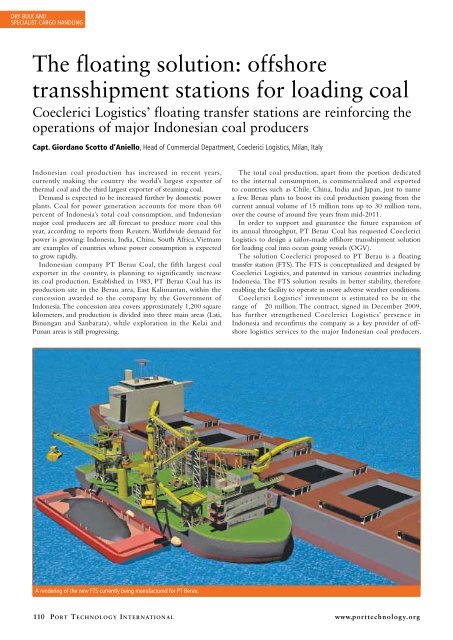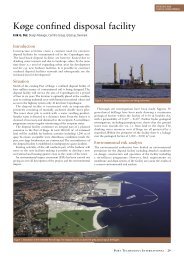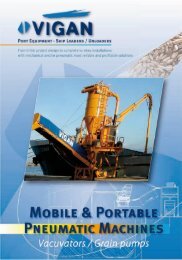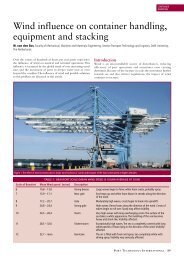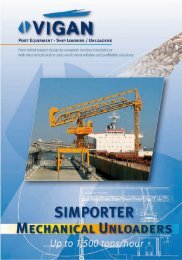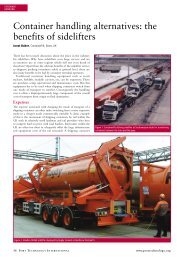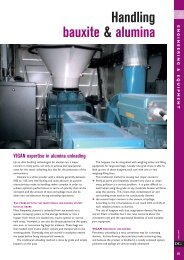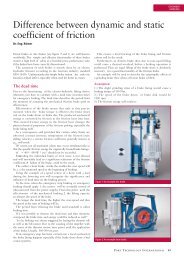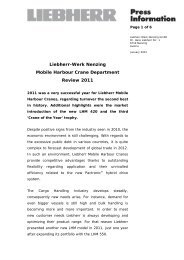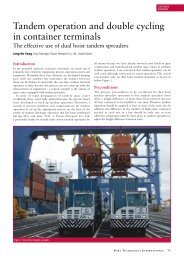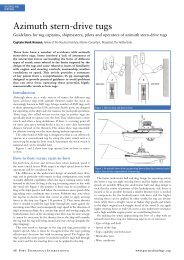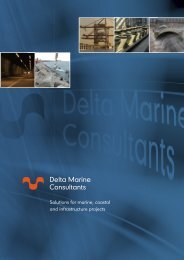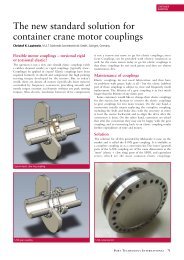Download the full article - Port Technology International
Download the full article - Port Technology International
Download the full article - Port Technology International
You also want an ePaper? Increase the reach of your titles
YUMPU automatically turns print PDFs into web optimized ePapers that Google loves.
DRY BULK andSPECIALIST CARGO HANDLINGThe floating solution: offshoretransshipment stations for loading coalCoeclerici Logistics’ floating transfer stations are reinforcing <strong>the</strong>operations of major Indonesian coal producersCapt. Giordano Scotto d’Aniello, Head of Commercial Department, Coeclerici Logistics, Milan, ItalyIndonesian coal production has increased in recent years,currently making <strong>the</strong> country <strong>the</strong> world’s largest exporter of<strong>the</strong>rmal coal and <strong>the</strong> third largest exporter of steaming coal.Demand is expected to be increased fur<strong>the</strong>r by domestic powerplants. Coal for power generation accounts for more than 60percent of Indonesia’s total coal consumption, and Indonesianmajor coal producers are all forecast to produce more coal thisyear, according to reports from Reuters. Worldwide demand forpower is growing: Indonesia, India, China, South Africa, Vietnamare examples of countries whose power consumption is expectedto grow rapidly.Indonesian company PT Berau Coal, <strong>the</strong> fifth largest coalexporter in <strong>the</strong> country, is planning to significantly increaseits coal production. Established in 1983, PT Berau Coal has itsproduction site in <strong>the</strong> Berau area, East Kalimantan, within <strong>the</strong>concession awarded to <strong>the</strong> company by <strong>the</strong> Government ofIndonesia. The concession area covers approximately 1,200 squarekilometers, and production is divided into three main areas (Lati,Binungan and Sanbarata), while exploration in <strong>the</strong> Kelai andPunan areas is still progressing.The total coal production, apart from <strong>the</strong> portion dedicatedto <strong>the</strong> internal consumption, is commercialized and exportedto countries such as Chile, China, India and Japan, just to namea few. Berau plans to boost its coal production passing from <strong>the</strong>current annual volume of 15 million tons up to 30 million tons,over <strong>the</strong> course of around five years from mid-2011.In order to support and guarantee <strong>the</strong> future expansion ofits annual throughput, PT Berau Coal has requested CoeclericiLogistics to design a tailor-made offshore transshipment solutionfor loading coal into ocean going vessels (OGV).The solution Coeclerici proposed to PT Berau is a floatingtransfer station (FTS). The FTS is conceptualized and designed byCoeclerici Logistics, and patented in various countries includingIndonesia. The FTS solution results in better stability, <strong>the</strong>reforeenabling <strong>the</strong> facility to operate in more adverse wea<strong>the</strong>r conditions.Coeclerici Logistics’ investment is estimated to be in <strong>the</strong>range of €20 million. The contract, signed in December 2009,has fur<strong>the</strong>r streng<strong>the</strong>ned Coeclerici Logistics’ presence inIndonesia and reconfirms <strong>the</strong> company as a key provider of offshorelogistics services to <strong>the</strong> major Indonesian coal producers.A rendering of <strong>the</strong> new FTS currently being manufactured for PT Berau.110 P o rt <strong>Technology</strong> Internat i o n a l www.porttechnology.org
DRY BULK andSPECIALiST CARGO HANDLINGThe contract provides for a minimum guaranteed quantity ofabout 40 million mt during its ten years duration. The FTS willbe able to perform a loading rate in excess of 30,000mt per day.FTS specificationThe FTS – presently under construction in China – is a nonpropelledbarge of approximately 11,000 DWT, duly designedto smoothly perform coal transloading while in operation at itsMuara Pantai anchorage.The FTS is equipped with two heavy-duty cranes and twoswiveling ship-loaders, along with a combination of hoppers andconveyors. European manufacturers will supply <strong>the</strong> whole of <strong>the</strong>handling system, as well as <strong>the</strong> main equipment. Accommodationwill be structural, and include <strong>the</strong> cargo control room and <strong>the</strong>crew living spaces.The FTS is designed with a minimum air draft of 18.5m atmaximum draft, making it able to transship an average of1,200t/h net in standard conditions (with a peak of 1,500t/h)from barges to OGV, up to cape-size vessels with a maximumbeam of 45m and maximum DWT of 180,000. Its mainprovisional dimensions are as per Table 1.Main equipmentTwo heavy-duty cranes of 30 tons SWL will be installed on <strong>the</strong>vessel starboard side towards amidship, in order to guarantee <strong>the</strong>optimization of <strong>the</strong> barge/FTS cycle. The system is furnishedwith grabs for coal of between 19.7m 3 and 22m 3 , as well as:• Two duly designed hoppers with belt-feeders• A belt conveyor system, designed to handle 2,000t/h of coal• Two ship-loaders with swiveling trimming spouts.Table 1: Main provisional dimensions of Coeclericifloating transfer stationCriteriaValueLOA: 97.00mBreadth (molded): 32.26mDepth (molded): 7.50mDraught (designed): 5.80mDeadweight at designed draught:approx. 11,000 tThe grabs are equipped with dust cover plates.The FTS is environmentally friendly and designed to meet<strong>the</strong> requirements of international classification societies such asIMO, MARPOL (SOPEP), IOPP, ISPP, IAPP; as well as localregulations and Coeclerici’s own standards.All conveyors and <strong>the</strong> loading boom are covered to shield coal from <strong>the</strong> wind.Hoppers designed with anti-spillage plates prevent coal falling into <strong>the</strong> sea.Coal spillage and pollution are prevented by <strong>the</strong> followingdevices:1. Duly designed hoppers: larger hoppers facilitate <strong>the</strong>operation of <strong>the</strong> crane driver. Hoppers are provided with antispillageplates so that <strong>the</strong> cargo spillage, if any, is collected inside<strong>the</strong> hoppers instead of falling into <strong>the</strong> sea.2. Grabs equipped with dust cover plates.3. Closed conveyor belts: all belts and <strong>the</strong> loading boom arecovered to avoid windborne dust and are kept clean by meansof scrapers.4. High-efficiency diesel generators: <strong>the</strong> internal combustionengines of <strong>the</strong> auxiliary generators are of high fuel efficiencytype, thus minimizing emissions.5. Sewage system: <strong>the</strong> sewage treatment unit is in accordancewith Class Rules.P o rt <strong>Technology</strong> Internat i o n a l 111


